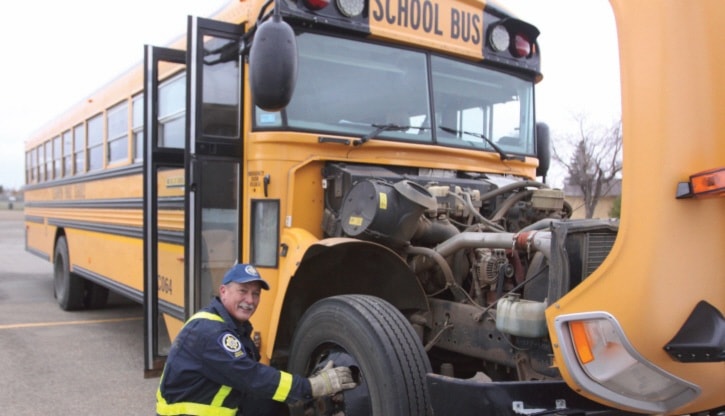An unannounced inspection on the school buses used to ferry students to-and-from the Stettler schools yielded no terrifying surprises last week.
On Wednesday, Oct. 15, bus drivers were notified that they were to report to the Stettler Community Centre after dropping off students at school for an inspection by the Commercial Vehicle Inspection (CVI) office, which reports to the Solicitor General’s Office.
There, trained inspectors would search for mechanical problems that were minor and need of repair, or so serious that the bus wouldn’t be considered safe and had to be taken from the road until the problem was fixed.
In this case, CVI’s Sgt Glenn Munden said that none of the buses failed the inspection, though some needed some minor repairs. He and inspectors from the central division have been running surprise inspections in Stettler County since the middle of September, and are slowly working their way west, Munden said. His inspection area covers almost all the way to the Saskatchewan border and includes several school districts besides Clearview Public School Board and East Central Alberta Catholic School Board that run the schools in the County of Stettler.
The seven inspectors made fairly quick work of the 13 buses in front of the community centre on Wednesday. To date, CVI has checked over 33 buses in the district, including buses in Botha, Big Valley, Stettler, Erskine and Donalda.
While all of the buses in Stettler passed, five of the 33 buses checked so far have not.
“That’s a little higher than I like to see,” Munden said. Some of the buses were driving for Clearview, though he wouldn’t say which schools the buses were driving for, just that they were repaired before going back on the road.
Some of the problems that would cause a bus to be taken out of duty would be a brake fluid leak, a fuel leak, or a flat tire, Munden said. In worst-case scenarios, drivers of the buses can face charges, though Munden noted that CVI works with the drivers, and most drivers are not trying to be unsafe or hide the issues.
“Laying charges is really the last resort,” Munden said, and is only used when a driver has repeat problems with his or her bus, or the problem is so obviously apparent and dangerous.
“That’s why we do these inspections,” he said. “Drivers are supposed to do a pre-trip inspection, so if we find a serious problem that they should have been aware of, yet chose to drive, it can have serious consequences.”
In Munden’s years with Stettler’s CVI office, there have been no bus incidents where mechanical problems were the cause or contributed to accidents.
School boards don’t necessarily face charges when buses are pulled from service, but they’re left in a lurch as they have to send out a replacement bus to transport the school children. In larger boards this isn’t a problem, but in small boards, like Clearview, there aren’t always a surplus of buses to draw from.
Drivers are notified when there are minor issues that need to be fixed, but aren’t serious enough to warrant the bus being taken from service. As an example, Munden suggested a loose exhaust clamp.
